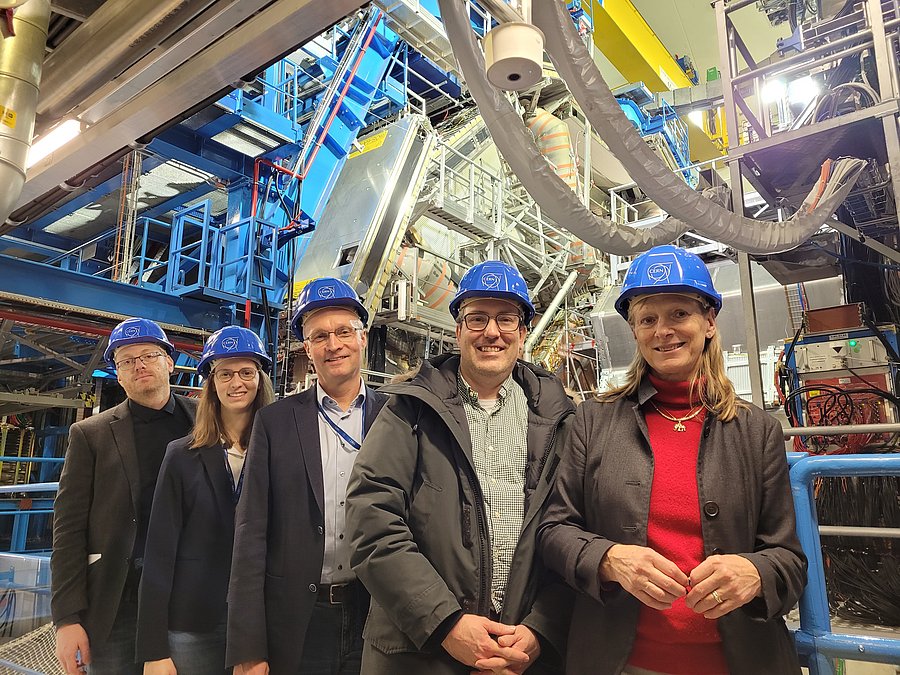Excursion
Members of the Rectorate visit CERN

A special kind of tour: University Rector Prof Dr Birgitta Wolff (right) and Vice-Rector Prof Dr Stefan Kirsch (2nd from right) visited CERN. They were accompanied by the scientists (from left) Dr Gerhard Brandt, Anna Bingham and Prof Dr Wolfgang Wagner // Photo CERN
Researchers from Wuppertal have been working at CERN since the early 1970s. They are currently involved in data collection, reconstruction and data analysis of the ATLAS detector, which is used to investigate a wide range of questions relating to the physics of elementary particles. Two proton beams from the Large Hadron Collider (LHC), the world's most powerful accelerator, collide in the detector.
Impressive programme of visits to the highlights of CERN
"Many people can't imagine much about research at large-scale physics facilities like CERN. The fact is that this seemingly abstract and complex type of research ultimately helps to answer important questions not only in the technical sciences, but also in medicine, for example," says University Rector Prof Dr Birgitta Wolff, explaining the versatility and benefits of the results.
Prof Dr Stefan Kirsch emphasises how important the existing research collaborations at CERN are for the University of Wuppertal: "Ever since the BUW has existed, experts from the university have been conducting research here in Switzerland and from the university laboratories on the big questions in physics. This is cutting-edge research that helps shape our expertise - from the elementary building blocks of matter to scientific high-performance computing in the digital age."
At the beginning of their stay, the visitors were welcomed by CERN's Director of International Relations, Charlotte Warakaulle, in the CERN Directorate building. After a short overview lecture on the history and scientific objectives of CERN, the tour began with a visit to the computer centre and the CERN control centre on the Prevessin campus, from where the CERN accelerators, which form the heart of the research centre, are controlled.
The rector and vice-rector were then able to visit a section of the LHC tunnel, which has a total length of 27 kilometres, at a depth of 90 metres. Further insights into the technology of the LHC and the experiments set up at the accelerator were provided in the new Science Gateway science museum, which will be opened in 2023 and was largely financed by donations.
Tour of the ATLAS detector
The next stop was the ATLAS detector. The detector has impressive dimensions, 44 metres long and 25 metres high, and is only accessible during breaks in operation. The group of visitors, which also included Wuppertal scientist Dr Gerhard Brandt, who is based at CERN, and Wuppertal doctoral student Anna Bingham, was led by the spokesperson for the ATLAS collaboration, Dr Andreas Höcker.
He explained how the detector works and emphasised the important contributions of the Wuppertal working group to the construction and modification of the silicon pixel detector, which is located at the centre of ATLAS and provides very precise location information on the trajectory of the particles produced in the collisions.
Wuppertal builds the new ATLAS detector
On the second day, Prof Wagner took the visitors to a laboratory where preparations are underway for the assembly of the new pixel detector, which is due to go into operation in 2030. The Wuppertal physicists have been developing components for the new detector since 2015. 60 physics institutes worldwide are involved in the new construction project. They deliver components that they have produced in their institutes and in some cases with partners in industry to CERN, where they are assembled into the detector. The first detector modules are available and are undergoing intensive testing in the laboratory at CERN.
